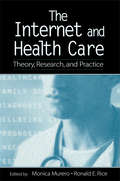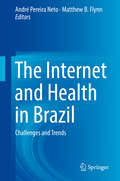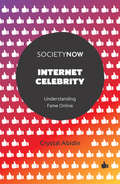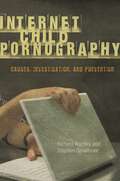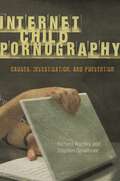- Table View
- List View
The Internet and Formations of Iranian American-ness: Next Generation Diaspora
by Donya AlinejadThis book explores how the children of Iranian immigrants in the US utilize the internet and develop digital identities. Taking Los Angeles—the long-time media and cultural center of Iranian diaspora—as its ethnographic field site, it investigates how various web platforms are embedded within the everyday social, cultural, and political lives of second generation Iranian Americans. Donya Alinejad unpacks contemporary diasporic belonging through her discussion of the digital mediation of race, memory, and long-distance engagement in the historic Iranian Green Movement. The book argues that web media practices have become integral to Iranian American identity formation for this generation, and introduces the notion of second-generation “digital styles” to explain how specific web applications afford new stylings of diaspora culture.
The Internet and Formations of Iranian American-ness: Next Generation Diaspora
by Donya AlinejadThis book explores how the children of Iranian immigrants in the US utilize the internet and develop digital identities. Taking Los Angeles—the long-time media and cultural center of Iranian diaspora—as its ethnographic field site, it investigates how various web platforms are embedded within the everyday social, cultural, and political lives of second generation Iranian Americans. Donya Alinejad unpacks contemporary diasporic belonging through her discussion of the digital mediation of race, memory, and long-distance engagement in the historic Iranian Green Movement. The book argues that web media practices have become integral to Iranian American identity formation for this generation, and introduces the notion of second-generation “digital styles” to explain how specific web applications afford new stylings of diaspora culture.
The Internet and Health Care: Theory, Research, and Practice (Routledge Communication Series)
by Monica Murero Ronald E. RiceThe Internet and Health Care: Theory, Research, and Practice presents an in-depth introduction to the field of health care and the Internet, from international and interdisciplinary perspectives. It combines expertise in the areas of the social sciences, medicine, policy, and systems analysis. With an international collection of contributors, it provides a current examination of key issues and research projects in the area. Methods and data used in the chapters include personal interviews, focus groups, observations, regional and national surveys, online transcript analysis, and much more. Sections in the book cover:*e-Health trends and theory; *searching, discussing, and evaluating online health information at the individual level of analysis; *discussing health information at the group or community level; and *implementing health information systems at the regional and social level. The Internet and Health Care will prove useful for university educators and students in the social, public health, and medical disciplines, including Internet researchers. It is also oriented to professionals in many disciplines who will appreciate an integrative theoretical, empirical, and critical analysis of the subject matter, including developers and providers of online health information.
The Internet and Health Care: Theory, Research, and Practice (Routledge Communication Series)
by Monica Murero Ronald E. RiceThe Internet and Health Care: Theory, Research, and Practice presents an in-depth introduction to the field of health care and the Internet, from international and interdisciplinary perspectives. It combines expertise in the areas of the social sciences, medicine, policy, and systems analysis. With an international collection of contributors, it provides a current examination of key issues and research projects in the area. Methods and data used in the chapters include personal interviews, focus groups, observations, regional and national surveys, online transcript analysis, and much more. Sections in the book cover:*e-Health trends and theory; *searching, discussing, and evaluating online health information at the individual level of analysis; *discussing health information at the group or community level; and *implementing health information systems at the regional and social level. The Internet and Health Care will prove useful for university educators and students in the social, public health, and medical disciplines, including Internet researchers. It is also oriented to professionals in many disciplines who will appreciate an integrative theoretical, empirical, and critical analysis of the subject matter, including developers and providers of online health information.
The Internet and Health in Brazil: Challenges and Trends
by André Pereira Neto Matthew B. FlynnThe popularization of the Internet, due in larger part to the advent of multifunctional cell phones, poses new challenges for health professionals, patients, and caregivers as well as creates new possibilities for all of us. This comprehensive volume analyzes how this social phenomenon is transforming long-established healthcare practices and perceptions in a country with one of the highest numbers of Internet users: Brazil. After an opening text that analyzes the Internet and E-Health Care as a field of study, the book comprises six parts. The first part introduces the emergence and development of the internet in Brazil, its pioneering experience in internet governance, digital inclusion, and online citizen participation. The second part is dedicated to internet health audiences by analyzing the cases of patients, the young, and the elderly seeking and sharing health information online, especially in virtual communities. The third part is dedicated to the challenges that the expansion of the internet in healthcare poses to all of us, such as the evaluation of the quality of health information available online and the prevention of the risks involved with online sales, cyberbullying, and consumption of prescription medicines. The fourth presents some innovative e-learning experiences carried out with different groups in Brazil, while the fifth part analyses some practical applications involving the Internet and health, including studies on M-Health, the Internet of things, serious games and the use of new information and communication technologies in health promotion. The last chapter analyses the future of healthcare in the Internet Age. The authors establish a critical and creative debate with international scholarship on the subject. This book is written in a direct and comprehensible way for professionals, researchers, students of communication and health, as well as for stakeholders and others interested in better understanding the trends and the different challenges related to the social phenomenon of the internet in health.
The Internet and New Social Formation in China: Fandom Publics in the Making (Media, Culture and Social Change in Asia)
by Weiyu ZhangThere are billions of internet users in China, and this number is continually growing. This book looks at the various purposes of this internet use, and provides a study about how the entertainment-consuming users form into publics through the mediation of technologies in the era of network society. It questions how individuals, mediated by new information and communication technologies, come together to form new social categories. The book goes on to investigate how public(s) is formed in the era of network society, with particular focus on how fans become publics in a society that follows the logic of network. Using online surveys and in-depth interviews, this book provides a rich description of the process of constructing a new social formation in contemporary China.
The Internet and New Social Formation in China: Fandom Publics in the Making (Media, Culture and Social Change in Asia)
by Weiyu ZhangThere are billions of internet users in China, and this number is continually growing. This book looks at the various purposes of this internet use, and provides a study about how the entertainment-consuming users form into publics through the mediation of technologies in the era of network society. It questions how individuals, mediated by new information and communication technologies, come together to form new social categories. The book goes on to investigate how public(s) is formed in the era of network society, with particular focus on how fans become publics in a society that follows the logic of network. Using online surveys and in-depth interviews, this book provides a rich description of the process of constructing a new social formation in contemporary China.
The Internet and Political Protest in Autocracies (Oxford Studies in Digital Politics)
by Nils B. Weidmann Espen Geelmuyden RødEight years after the Arab Spring there is still much debate over the link between Internet technology and protest against authoritarian regimes. While the debate has advanced beyond the simple question of whether the Internet is a tool of liberation or one of surveillance and propaganda, theory and empirical data attesting to the circumstances under which technology benefits autocratic governments versus opposition activists is scarce. In this book, Nils B. Weidmann and Espen Geelmuyden Rød offer a broad theory about why and when digital technology is used for one end or another, drawing on detailed empirical analyses of the relationship between the use of Internet technology and protest in autocracies. By leveraging new sub-national data on political protest and Internet penetration, they present analyses at the level of cities in more than 60 autocratic countries. The book also introduces a new methodology for estimating Internet use, developed in collaboration with computer scientists and drawing on large-scale observations of Internet traffic at the local level. Through this data, the authors analyze political protest as a process that unfolds over time and space, where the effect of Internet technology varies at different stages of protest. They show that violent repression and government institutions affect whether Internet technology empowers autocrats or activists, and that the effect of Internet technology on protest varies across different national environments.
Internet and Social Change in Rural Indonesia: From Development Communication to Communication Development in Decentralized Indonesia
by Subekti PriyadharmaThis book is based on an empirical research which explores bottom-up development practices initiated and organized by rural communities in the Indonesian periphery by placing “communication” at its core of analysis. The aim is to determine the extent that the Indonesian decentralization policy and the use of internet and other digital Information and Communication Technologies (ICTs) has affected the theory and practice of development communication as well as changes in relations between the center and the periphery within the context of Indonesian rural development. The book takes on periphery perspective in center-periphery interactions and relations. Hence, it belongs to "periphery research" that has rarely been used in recent decades. By using Grounded Theory for its data collection and analysis method, the results of this study are grouped into two major thematic categories: “communication development”, instead of development communication, and “communication empowerment”.
The Internet and Social Inequalities
by James C. Witte Susan E. MannonIdeal for use as a core or secondary text in lower division social inequalities or social problems courses, this book explains how the changing nature and uses of the Internet not only mirror today’s social inequalities, but also are at the heart of how stratification is now taking place.? A pioneering work, both intellectually, and pedagogically.
The Internet and Social Inequalities
by James C. Witte Susan E. MannonIdeal for use as a core or secondary text in lower division social inequalities or social problems courses, this book explains how the changing nature and uses of the Internet not only mirror today’s social inequalities, but also are at the heart of how stratification is now taking place.? A pioneering work, both intellectually, and pedagogically.
The Internet and the Customer-Supplier Relationship
by Stefano RonchiThis title was first published in 2003. An exhaustive and synthetic framework for the use of Internet tools in customer-supplier relationships is one aspect of e-business that is still missing from existing literature. This book analyses the main management implications related to the adoption of the Internet in the supply chain and unifies different research studies and contributions in order to build such a framework. It is based on wide empirical evidence including four in-depth case studies in both Europe and the US, a cross-industry survey of more than 160 US companies and website research describing emerging Internet initiatives in B2B relationships. By creating a concrete link between theory and practice it should appeal to academics and practitioners alike.
The Internet and the Customer-Supplier Relationship
by Stefano RonchiThis title was first published in 2003. An exhaustive and synthetic framework for the use of Internet tools in customer-supplier relationships is one aspect of e-business that is still missing from existing literature. This book analyses the main management implications related to the adoption of the Internet in the supply chain and unifies different research studies and contributions in order to build such a framework. It is based on wide empirical evidence including four in-depth case studies in both Europe and the US, a cross-industry survey of more than 160 US companies and website research describing emerging Internet initiatives in B2B relationships. By creating a concrete link between theory and practice it should appeal to academics and practitioners alike.
The Internet as Second Action Space
by Aharon KellermanOne of the most significant and important advancements in information and communication technology over the past 20 years is the introduction and expansion of the Internet. Now almost universally available, the Internet brings us email, global voice and video communications, research repositories, reference libraries, and almost unlimited opportunities for daily activities. Bridging geographical distances in unprecedented ways, the Internet has impacted all aspects of our daily lives – from facilitating the running of businesses, the attainment of services and keeping in touch with friends and family. Accessible at any time and for many of us from our mobile phones, the Internet has opened up a world of knowledge and communication platforms that we cannot now imagine living without. This book explores the concept that the Internet has become a second action space for individuals. Coexisting with traditional and "obvious" real space, the Internet serves as a novel spatial platform and action space to its subscribers all over the world. Kellerman expertly discusses this notion and examines the practical integration of cyberspace with real space. Part I examines the Internet as a platform for action and presents its relations with physical space concerning a range of uses and applications which were traditionally performed in physical space only. It discusses the idea that the Internet has become a second space and explores theoretical perspectives surrounding this notion. The Internet has undeniably made humankind more efficient and connected. Part II explores the Internet as an action space for human life, considering basic human needs, curiosity, identity and social relations. It further considers instances whereby use and application of the Internet cannot be fully performed in real space, mainly regarding people’s presentation of identity. Part III explores daily actions over the Internet, such as work, shopping, banking and social interactions. Kellerman also briefly touches on the darker aspects that the expansion of the Internet has made possible – including its role in fraud and other crimes. The concluding chapter discusses people living across the two spaces and identifies potential future developments. The Internet as Second Actions Space will appeal to students across the social sciences, in particular those studying Geography, Sociology, Media Studies, Internet Studies, Business and related disciplines.
The Internet as Second Action Space
by Aharon KellermanOne of the most significant and important advancements in information and communication technology over the past 20 years is the introduction and expansion of the Internet. Now almost universally available, the Internet brings us email, global voice and video communications, research repositories, reference libraries, and almost unlimited opportunities for daily activities. Bridging geographical distances in unprecedented ways, the Internet has impacted all aspects of our daily lives – from facilitating the running of businesses, the attainment of services and keeping in touch with friends and family. Accessible at any time and for many of us from our mobile phones, the Internet has opened up a world of knowledge and communication platforms that we cannot now imagine living without. This book explores the concept that the Internet has become a second action space for individuals. Coexisting with traditional and "obvious" real space, the Internet serves as a novel spatial platform and action space to its subscribers all over the world. Kellerman expertly discusses this notion and examines the practical integration of cyberspace with real space. Part I examines the Internet as a platform for action and presents its relations with physical space concerning a range of uses and applications which were traditionally performed in physical space only. It discusses the idea that the Internet has become a second space and explores theoretical perspectives surrounding this notion. The Internet has undeniably made humankind more efficient and connected. Part II explores the Internet as an action space for human life, considering basic human needs, curiosity, identity and social relations. It further considers instances whereby use and application of the Internet cannot be fully performed in real space, mainly regarding people’s presentation of identity. Part III explores daily actions over the Internet, such as work, shopping, banking and social interactions. Kellerman also briefly touches on the darker aspects that the expansion of the Internet has made possible – including its role in fraud and other crimes. The concluding chapter discusses people living across the two spaces and identifies potential future developments. The Internet as Second Actions Space will appeal to students across the social sciences, in particular those studying Geography, Sociology, Media Studies, Internet Studies, Business and related disciplines.
Internet Celebrity: Understanding Fame Online (SocietyNow)
by Crystal AbidinThe face of internet celebrity is rapidly diversifying and evolving. Online and mainstream celebrity culture are now weaving together, such that breakout stars from one-hit viral videos are able to turn their transient fame into a full-time career. This book presents a framework for thinking about the different forms of internet celebrity that have emerged over the last decade, taking examples from the Global North and South, to consolidate key ideas about cultures of online fame. It discusses the overall landscape, developments and trends in the internet celebrity economy, and cross-cultural lessons.
Internet Celebrity: Understanding Fame Online (SocietyNow)
by Crystal AbidinThe face of internet celebrity is rapidly diversifying and evolving. Online and mainstream celebrity culture are now weaving together, such that breakout stars from one-hit viral videos are able to turn their transient fame into a full-time career. This book presents a framework for thinking about the different forms of internet celebrity that have emerged over the last decade, taking examples from the Global North and South, to consolidate key ideas about cultures of online fame. It discusses the overall landscape, developments and trends in the internet celebrity economy, and cross-cultural lessons.
Internet Child Pornography: Causes, Investigation, and Prevention (Global Crime and Justice)
by Richard Wortley Stephen SmallboneThis book provides a comprehensive introduction to the problem of Internet child pornography that spotlights the connection between technology and behavior, presenting practical suggestions for reducing this pervasive problem.The role of the Internet in fueling the problem of child pornography is enormous. Prior to the Internet, child pornography was typically locally produced, of poor quality, expensive, and difficult to obtain. United States' law enforcement officials were able to boast in the late 1970s that the traffic in child pornography had virtually been eliminated. The advent of the Internet in the 1980s made vast quantities of child pornography instantly available in the privacy of the viewer's home. Today, child pornography largely exists because of the opportunities provided by the Internet.Internet Child Pornography provides a comprehensive overview of the issue by describing the problem of child pornography, examining the impact of the Internet, and presenting a profile of users. With this foundation in place, the authors then address responses to child pornography and shed light on the complexities of dealing with criminal activities that are perpetrated largely online—for example, the fact that people behave differently in online environments than they do in other areas of their lives. The book examines prevention efforts designed to reduce access to child pornography, law enforcement responses designed to catch known offenders, and treatment responses designed to reduce reoffending.
Internet Child Pornography: Causes, Investigation, and Prevention (Global Crime and Justice)
by Richard Wortley Stephen SmallboneThis book provides a comprehensive introduction to the problem of Internet child pornography that spotlights the connection between technology and behavior, presenting practical suggestions for reducing this pervasive problem.The role of the Internet in fueling the problem of child pornography is enormous. Prior to the Internet, child pornography was typically locally produced, of poor quality, expensive, and difficult to obtain. United States' law enforcement officials were able to boast in the late 1970s that the traffic in child pornography had virtually been eliminated. The advent of the Internet in the 1980s made vast quantities of child pornography instantly available in the privacy of the viewer's home. Today, child pornography largely exists because of the opportunities provided by the Internet.Internet Child Pornography provides a comprehensive overview of the issue by describing the problem of child pornography, examining the impact of the Internet, and presenting a profile of users. With this foundation in place, the authors then address responses to child pornography and shed light on the complexities of dealing with criminal activities that are perpetrated largely online—for example, the fact that people behave differently in online environments than they do in other areas of their lives. The book examines prevention efforts designed to reduce access to child pornography, law enforcement responses designed to catch known offenders, and treatment responses designed to reduce reoffending.
The Internet City: People, Companies, Systems and Vehicles (Cities series)
by Aharon KellermanAs the Internet develops, on top of earlier urban communications, facilities and media, it is becoming the site of urban communications on an unprecedented scale. Exploring the history of the Internet, from pre-conception to the possibilities of an Internet-based future, The Internet City explores ways in which the Internet and urban life intersect. The book interprets how the contemporary city is becoming fully based on Internet technologies in all of its major dimensions: the daily activities of urbanites and urban companies, the operations of urban systems, and the functioning of upcoming driverless vehicles. With particular focus on the ways in which people routinely consume urban services via the Internet, Aharon Kellerman examines how they are simultaneously present in physical and digital spaces. Urban geographers and urban planners will benefit from the detailed information on how the cityscape will be altered in the near future by the introduction of Internet-based autonomous vehicles. City policymakers will also find this a useful tool to explore how and why policies may need to be updated in accordance with the rising importance of the Internet in the urban sphere.
Internet Communication and Qualitative Research: A Handbook for Researching Online (PDF)
by Dr Chris Mann Dr Fiona Stewart`Internet Communication and Qualitative Research is a trailblazing introduction to data sources that will come to the fore in the new millennium. Its cogent discussion of the techniques, ethics and methods of analysis of Internet data should be read by every qualitative researcher' - David Silverman, Goldsmiths College `The internet is exploding with possibilities for conducting social research. Mann and Stewart offer the first in-depth consideration of the prospects and potentials for doing qualitative research on-line. This wide ranging, clearly-written book is essential reading for researchers working at the cutting edge of qualitative methodology' - James A. Holstein, Marquette University `This is e-scholarship. The book is a transformative project which brings the best skills of the old print scholarship to the cyberworld. The authors are no mere theoreticians - but hands-on net-users, who have made the imaginative leap to the dot.com world, and who have mapped the way for net research and researchers. The authors are pioneers in the realm of digit-crit - opening the way with their critical evaluation of the digital media and net research. They profile the skills required by the online researcher and evaluate the context in which they are used - in relation to privacy, security, ethics and legal considerations. They also take up issues of power; they explore the social and political implications of the digital media, (with specific reference to gender) and the role of the online researcher. An absolute must for cybercitizens and an indispensable guide for students, researchers, and knowledge workers in the dot.com world' - Dale Spender `Mann and Stewart have prized open the mysteries of on-line qualitative research. For those new to this methodology the technology review demystifies; the social science research ethics issues are re-addressed with reference to the on-line situation; methods of conducting online focus groups and interviews, in particular, are detailed. The tone is both analytical and practical with a host of techniques suggested. I recommend this accessible text for all qualitative researchers, both academic and practitioner' - Rehan Ul-Haq, University of Birmingham Business School `Here is the clear, useful guide to the Internet research needed by all of us interested in on-line relationships and research. The authors address such issues as ethics, confidentiality, the theory and practice of on-line research, and on-line power relationships (which will be of concern in distance learning plans and programs). A very valuable book.' - Cheris Kramarae, Center for the Study of Women in Society, University of Oregon
Internet Communication Technology: Applied Phronesis Netnography in Internet Research Methodologies (Lecture Notes in Social Networks)
by Iyad Muhsen AlDajaniThe book explores Applied Phronesis in internet communication technology and Netnography application, introducing it on Facebook and YouTube usages. It defines two pillars for the research dynamics, “Episteme” and “Techne.” – the know-how, how-to, and the power dynamics. The “Episteme” explores the dynamics of reconciliation in the middle of conflict, Internet communication technologies for transformation, Moderation in Islam, online Deliberative Democracy.The second pillar, “Techne,” is explored through Internet communication technology for the advancement of reconciliation in the middle of a conflict.The book describes the Phronetic Approach in internet research in academic discourse adopting Phronesis “an Aristotelian concept and method defined by Bent Flyvbjerg,” and exploring Netnography for Kozinets, in Mixed-Method research design and applying methodological triangulation in research and testing the hypothesis using qualitative content analysis for Krippendorff, developing a methodological discourse for interdisciplinary research using internet communication technologies as part of understanding big-date, introducing Applied Digital Humanities.
Internet Culture
by David PorterThe internet has recently grown from a fringe cultural phenomenon to a significant site of cultural production and transformation. Internet Culture maps this new domain of language, politics and identity, locating it within the histories of communication and the public sphere. Internet Culture offers a critical interrogation of the sustaining myths of the virtual world and of the implications of the current mass migration onto the electronic frontier. Among the topics discussed in Internet Culture are the virtual spaces and places created by the citizens of the Net and their claims to the hotly contested notion of "virtual community"; the virtual bodies that occupy such spaces; and the desires that animate these bodies. The contributors also examine the communication medium behind theworlds of the Net, analyzing the rhetorical conventions governing online discussion, literary antecedents,and potential pedagogical applications.
Internet Culture
by David PorterThe internet has recently grown from a fringe cultural phenomenon to a significant site of cultural production and transformation. Internet Culture maps this new domain of language, politics and identity, locating it within the histories of communication and the public sphere. Internet Culture offers a critical interrogation of the sustaining myths of the virtual world and of the implications of the current mass migration onto the electronic frontier. Among the topics discussed in Internet Culture are the virtual spaces and places created by the citizens of the Net and their claims to the hotly contested notion of "virtual community"; the virtual bodies that occupy such spaces; and the desires that animate these bodies. The contributors also examine the communication medium behind theworlds of the Net, analyzing the rhetorical conventions governing online discussion, literary antecedents,and potential pedagogical applications.
Internet Dating: Intimacy and Social Change (Routledge Advances in Sociology)
by Chris Beasley Mary HolmesInternet Dating deals primarily with the experiences of UK and Australian daters, examining their online accounts to see what kinds of narratives, norms, emotions and ‘chemistry’ shape their dating. Has the emergence and growth of internet dating changed the dating landscape for the better? Most commentators, popular and academic, ask whether online dating is more efficient for individuals than offline dating. We prefer a socio-political perspective. In particular, the book illustrates the extent to which internet dating can advance gender and sexual equality. Drawing on the voices of internet daters themselves, we show that internet dating reveals how social change often arises in the unassuming, everyday and familiar. We also pay attention to often ignored older daters and include consideration of daters in Africa, Scandinavia, South America, Asia and the Middle East. Throughout, we explore the pitfalls and pleasures of men and women daters navigating unconventional directions towards more equitable social relations.

